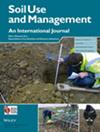Assessing the effect of Lake Erie dredged sediment on soil properties and specialty crops development
IF 3.7
3区 农林科学
Q1 SOIL SCIENCE
引用次数: 0
Abstract
To maintain harbour navigability, significant quantities of sediments are annually dredged and disposed of in the vicinities of Lake Erie. This study aimed to assess the impact of Lake Erie sediment on the productivity of tomatoes, lettuce, and carrots. Using a greenhouse setting, this experiment evaluates different sediment‐farm soil ratios: 100% farm soil (Farm Soil), 100% lake sediment (Sediment), and a blend of 10% dredge sediment and 90% farm soil (Mixture). We evaluated the chemical and physical composition of the treatments and the development of the roots, leaves, and fruit production for each crop. Additionally, Total Organic Carbon (TOC), Total Nitrogen (TN), and Total Phosphorus (TP) were assessed post‐harvest for each crop's roots, leaves, and fruit biomass. The Sediment treatment showed higher pH, Cation Exchange Capacity (CEC), Calcium, and TOC but lower magnesium, phosphate, and potassium compared to Farm Soil. The Sediment and Mixture treatments exhibited higher root and leaf dry weights for lettuce compared to Farm Soil, with the Sediment treatment showing the longest roots. Sediment and Mixture treatments in carrots led to greater root weight and length. Tomatoes submitted to the Sediment treatment excelled in all variables except stem diameter. Lettuce and carrot biomass analysis revealed no statistical differences in TOC and TN among the treatments. Tomato biomass analysis showed no differences among the three treatments. The use of Lake Erie dredged sediment led to increased crop biomass in the greenhouse production of tomatoes, carrots, and lettuce.评估伊利湖疏浚沉积物对土壤性质和特种作物生长的影响
为了保持港口的通航能力,每年都要在伊利湖附近疏浚和处理大量沉积物。本研究旨在评估伊利湖沉积物对西红柿、莴苣和胡萝卜产量的影响。本实验采用温室环境,评估了不同的沉积物-农田土壤比例:100% 农田土壤(农田土壤)、100% 湖泊沉积物(沉积物)以及 10% 疏浚沉积物和 90% 农田土壤的混合物(混合物)。我们评估了各处理的化学和物理成分,以及每种作物的根、叶和果实的生长情况。此外,我们还评估了每种作物收获后根系、叶片和果实生物量的总有机碳(TOC)、总氮(TN)和总磷(TP)。与农田土壤相比,沉积物处理显示出较高的 pH 值、阳离子交换容量(CEC)、钙和总有机碳,但镁、磷酸盐和钾较低。与农田土壤相比,沉积物和混合物处理的莴苣根和叶干重更高,其中沉积物处理的莴苣根最长。沉积物和混合物处理可使胡萝卜的根重和根长增加。采用沉积物处理的西红柿在除茎直径外的所有变量中都表现优异。生菜和胡萝卜的生物量分析表明,各处理的总有机碳(TOC)和总氨(TN)没有统计学差异。番茄生物量分析表明,三种处理之间没有差异。在温室番茄、胡萝卜和莴苣生产中,使用伊利湖疏浚沉积物可增加作物生物量。
本文章由计算机程序翻译,如有差异,请以英文原文为准。
求助全文
约1分钟内获得全文
求助全文
来源期刊

Soil Use and Management
农林科学-土壤科学
CiteScore
7.70
自引率
13.20%
发文量
78
审稿时长
3 months
期刊介绍:
Soil Use and Management publishes in soil science, earth and environmental science, agricultural science, and engineering fields. The submitted papers should consider the underlying mechanisms governing the natural and anthropogenic processes which affect soil systems, and should inform policy makers and/or practitioners on the sustainable use and management of soil resources. Interdisciplinary studies, e.g. linking soil with climate change, biodiversity, global health, and the UN’s sustainable development goals, with strong novelty, wide implications, and unexpected outcomes are welcomed.
 求助内容:
求助内容: 应助结果提醒方式:
应助结果提醒方式:


